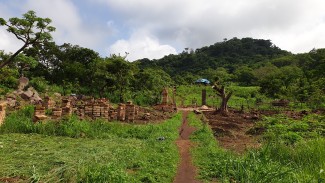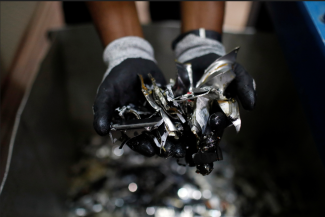Country is addressing its fragility through renewed efforts to stimulate economy
Chad is the largest landlocked country in Africa.
It has among the highest trade costs, with the nearest port in Doula, Cameroon 1,800 kilometres away. And, the country has seen decades of armed conflict and has an economy largely dependent on oil.
That dependency means the country is vulnerable to price fluctuations, which can have an outsized impact on its impoverished population.
“Chad is a net importer, depending heavily on the outside world to meet its domestic food needs and supply it with other manufactured products. It exports some items, including cotton lint, livestock and other unprocessed or semi-processed products, notably gum arabic, groundnuts and sesame,” said M Mahamat Touka Saleh, who works at the Chad Ministry of Mining, Trade and Industrial Development, and Promotion of the Private Sector.
“Diversification of exports requires new investments. As a result, men and women, including disabled persons in rural areas, will have productive, decent and sustainable jobs,” said Saleh, who is the Enhanced Integrated Framework (EIF) National Implementation Unit Coordinator.
The country’s strong economic growth, reaching up to 7.4% between 2003 and 2015, was largely due to its oil resources. With a significant fall in oil prices and negative growth rates, the annual average income dropped from USD$980 to $670 between 2014 and 2017, according to the World Bank.
While economic recovery is expected to continue in 2020, Chad wants to ensure that growth is sustainable now by diversifying into other sectors with high export potential.
INVESTING IN THE FUTURE
Economic diversification can contribute to a country’s stability – including macroeconomically and in terms of security – but it’s not easy to achieve. Chad and other fragile countries like Mali, Niger and Guinea have made unsuccessful attempts at diversifying their economies since the 1990s. Those efforts were difficult because of the nature of the conflicts happening as well as structural issues and lack of skilled labour, all which impede trade development.
“The agriculture sector is the most important to the population of Chad, with the people mainly living in the countryside. In terms of objectives for diversification, Chad wants to streamline the weight of its agricultural sector in the national economy and have other sectors more prominent and able to generate employment. This could mean having more industrialization, so this involves doing something different and the challenge is that it involves markets abroad. The idea would be a kind of diversification that integrates industrial processes for food products in order to generate a value addition that can benefit better the economy,” said Khalid El Bernoussi, Consultant, Project Manager and Adviser for Summit Alliances International.
Export diversification creates jobs, accelerates growth and can foster the foreign direct investment and private sector investment the country needs – all of which have been impeded by security tensions in the country.
“Livestock is one of the most important sectors of the Chadian economy, especially in reducing poverty and improving food security. Livestock represents 53% of GDP and is the livelihood for about 40% of the population. It is the second largest source of income after oil,” said Saleh.
However, 8% export duties and levies of up to CFAF 5,00 per head of cattle and camels make it more difficult for livestock exporters to compete in the world market.
“The full potential of the leather sector also remains untapped. The techniques for preserving and tanning leather are traditional, inefficient and do not meet international technical standards. Current efforts in boosting the Chadian leather sector range from developing market infrastructure to improving quality to ensuring the dissemination of best practices,” he said.
For Chad, its gum arabic potential is also huge.
The country’s efforts towards diversification have turned it into a significant player in the world trade of gum arabic – an additive contained in frizzy drinks, food and cosmetics. Chad is among the top three world exporters, exporting over 13,000 tons of crude gum arabic between 2014 and 2016.
Chad has made considerable progress, and is working with international institutions like EIF, the United Nations Industrial Development Organization (UNIDO), the United Nations Development Programme (UNDP) and the International Trade Centre (ITC). Today, a new brand – “Cristal of Chad” – is reaching new export markets. According to ITC, the volume of gum arabic exports is expected to double in the next five years, with India being among the top target markets.
“Key priorities for the future include moving up the value chains in shea butter, dates, natron and sesame,” said Saleh.
STAYING STABLE
Evidence shows that in fragile contexts trade flows play an important role: they are larger than other external flows and yet extremely concentrated in primary commodities. Swings in commodity prices and revenue volatility can have a destabilizing effect, and this is even more pronounced for certain export commodities, including oil and gas.
While stabilization funds and greater transparency around natural response management can help, a more structural response would pave a path towards export diversification.
Moving away from oil dependence requires significant work – and money. A situation that many least developed countries (LDCs), of which Chad is one, are facing.
“There is a need for a combination of the national dynamic undertaken in the country and also what you have at the World Trade Organization of international standards for trade. And, actually, if you want to contribute efficiently to the development of the local economy from a national perspective you also need to have strong support and international regulation. For the LDCs they need flexible rules in terms of international trade to facilitate their integration into the global economy,” said El Bernoussi.
He added, “It all goes together, international trade regulations need to be flexible enough to allow the LDCs to engage in national processes that accelerate their economies.”
Chad's Vision 2030 aims to do just that acceleration, with four key priorities: promoting peace, strengthening good governance and rule of law, ensuring economic diversification and improving quality of life.
Header image of a COVID quarantine center in Ethiopia - ©UNICEFEthiopi/2020/NahomTesfaye via Flickr Creative Commons Attribution-NonCommercial-NoDerivs 2.0 Generic (CC BY-NC-ND 2.0) license.
If you would like to reuse any material published here, please let us know by sending an email to EIF Communications: eifcommunications@wto.org.



